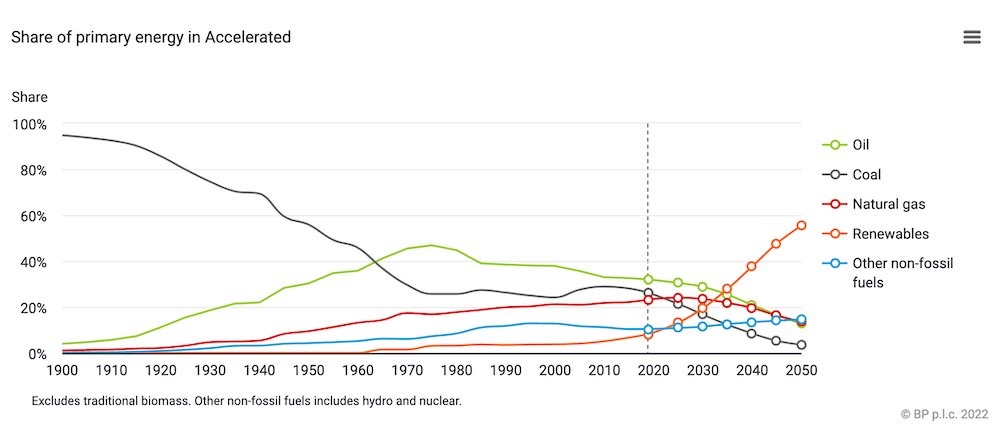Oil giant BP has warned that the world is locking itself in for a costly and disorderly transition to net-zero emissions, where continued delays to decisive action greatly increase the economic and social costs of trying to remain within the carbon budget.
In a “Core Beliefs” summary of its latest Energy Outlook, BP details how every year in which decisive action to reduce global carbon emissions is delayed, the difficulty – and cost – of staying within the budget increases significantly.
“The nature of the finite carbon budget consistent with achieving the Paris climate goals means that every year in which decisive action to reduce global carbon emissions is delayed, the difficulty of staying within the budget significantly increases,” the report says.
“This raises the risk that an extended period of delay could greatly increase the economic and social costs associated with trying to remain within the carbon budget.”
BP’s Energy Outlook, published this week, draws on three scenarios that represent a range of possible pathways forward for the global energy system through to 2050.
These scenarios increase in ambition, starting with “New Momentum,” which captures the “broad trajectory along which the global energy system is currently progressing.”
As illustrated in the charts below, the next best scenario, “Delayed and Disorderly,” assumes that global emissions reduction efforts continue at the same pace as New Momentum for the rest of the 2020s, before drastically ramping up in a race to meet Paris targets.
As BP explains, “it highlights an important feature of the carbon budget that, even if improvements in energy efficiency and switching to low-carbon fuels occur at historically unprecedented rates, achieving the same level of cumulative CO2e emissions … as in [the most ambitious scenario] would likely be possible only if final energy consumed over that period was substantially lower.”
So, while this scenario does eventually get to the same spot as the highly preferable “Accelerated” scenario, by 2050 – which according to BP’s modelling, still falls short of net-zero emissions – the cost of getting there is much higher.
That is, total final energy consumption needs to be around 40% lower than in Accelerated to meet the same carbon budget, which in turn suggests that energy use would need to be significantly rationed and constrained.
“Although not modelled explicitly, the restrictions and controls needed to achieve this lower level of energy consumption are likely to have a significant cost on both economic activity and levels of well-being,” the report says.
Even according to BP’s Accelerated scenario, the world does not get where it needs to be according to the science. On primary energy, the mix only reaches a 65% share of renewables by 2050, with fossil fuels falling to account for 20%.
Electricity consumption increases to between 75% and 85% in all three scenarios, and the share of electricity at the final point of use increasing from 20% in 2019 to around 30% under the New Momentum scenario and between 45-50% in the Accelerated and Net Zero scenarios.
Low-carbon hydrogen plays a significant role in the energy mix, accounting for between 6% and 8% in total final energy consumption by 2050 in both Accelerated and Net Zero, with total hydrogen demand nearly double this.
In terms of renewable energy generation, BP expects wind and solar power generation to increase by around 20-fold by 2050 in both Accelerated and Net Zero, increasing to around 40,000-45,000TWh and more than accounting for the entire growth in global power generation.
Specifically, wind and solar power will account for around 70% of global power generation – and closer to 80% in the most advantaged regions – in Accelerated and Net Zero, powering both end-use activity as well as helping to produce green hydrogen.
The rate of increase in installed global wind and solar capacity in both Accelerated and Net Zero is between 600-750GW per year in the 2030s and up to 700-750GW per year in the 2040s – which is “two or three times faster than the highest rate of increase seen in the past.”
Further, as the report indicates, “This rapid acceleration in the installation of wind and solar capacity is dependent on a range of enabling factors scaling at a similar rate, including transmission and distribution capacity, availability of key materials, planning and permitting, and social acceptability.”
Conversely, BP sees coal “virtually eliminated from global power generation by 2050” in its two more ambitious scenarios, while natural gas declines dramatically over the second half of the outlook towards 2050 as the expansion of wind and solar power gathers pace.
Importantly, BP also sees road transportation as a key area of electrification. It sees the share of electric vehicles (including both pure battery EVs and PHEVs) in new vehicle sales increases from 2% in 2019 to between 25-30% in 2030 and around 90% in 2050 in both Accelerated and Net Zero scenarios.
BP chief economist Spencer Dale notes in his introduction to the report that “government ambitions globally to tackle climate change have increased markedly, but have yet to translate into sufficient action.
“Other than the COVID-19-induced dip in 2020, carbon emissions have risen in every year since 2015, the year of the Paris COP,” he says.
“The carbon budget is finite, and it is running out: further delays in reducing CO2 emissions could greatly increase the economic and social costs associated with trying to remain within the carbon budget.”












